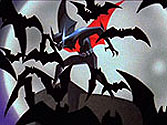 |
 Epilogue
Epilogue
Terry discovers a long-hidden secret about his past.
Original Airdate: July 23, 2005
Episode # #26 (JLU)
Rating: * * * *
|
||
|
|
|
| Credits | Cast | |
Story by Bruce Timm & Dwayne McDuffie Teleplay by Dwayne McDuffie Directed by Dan Riba Music by Lolita Ritmanis & Kris Carter Animation by Dong Woo |
Will Friedle as Terry McGinnis Kevin Conroy as Bruce Wayne CCH Pounder as Amanda Waller |
Lauren Tom as Dana, Dr. Light Hynden Walch as Ace Marc Worden as Parasite |
|
|
|
Thematically, it is a mad, multi-dimensional Moebius strip. Without summarizing, condensing, or compartmentalizing the various Batman series, this episode of Justice League Unlimited glances off events and motifs that Bruce Timm and his collaborators have played with over the years. It returns to the animated series’ roots with a cameo by the Phantasm; a chilling plot worthy of the reanimated Joker or Ra's al-Ghul; a hitherto unimagined origin for Terry McGinnis; and a kiss blown to Batman’s first animated appearance. It plays hide-and-seek with questions of fate, character formation, and the location of the Batman “soul.” It brings closure to a too-delayed issue in Terry’s life. And it suggests that two men can be father and son in more ways than one without that relation being any less of a coincidence. To unpack its many meanings and detours would take a longer essay than I intend, and it would require of the reader a very thorough knowledge of the animated continuity and its implications. It would also fail utterly to touch on how and why this episode sings like a golden-throated vibrato held at the caesura of a fin-de-siecle aria. But let me sketch some of those elements while merely acknowledging the obvious: that the story's chief glory comes in the obliqueness of its treatment and in the daringness of the execution. The story’s greatest puzzle, and its most dangerous trap for an unsympathetic critic, comes with its suggestion that “Batman” has his origins in reductive, socio-physical facts. Someone with Bruce Wayne’s genes wouldn’t necessarily become Batman; someone orphaned by a wanton criminal wouldn’t necessarily become Batman either. Hence, it appears that someone who--like Amanda Waller--wishes to create Batman must arrange a fortuitous collision of genetic disposition and tragic circumstance. “Epilogue” is the story of Terry McGinnis’ discovery that he is the product of just such a callous arrangement. The viewer who stops with this recognition will be deeply vexed because he will have stopped with a conclusion sharply at odds with what Batman Beyond has demonstrated over the arc of its existence. Character is not formed in one explosive moment; it is formed by dozens, even hundreds, of individual choices. The implication of “Epilogue” is thus refuted by the particular proofs of “Rebirth,” “Lost Soul” and Return of the Joker, as well as by the accumulated proofs of every other Batman Beyond story. Such a viewer may feel as betrayed by the revelations of the story as Terry.
“Epilogue” raises this reductive explanation, then, only to expose it for a sham. Why go to all this trouble? Because in doing so, it also manages to expose and dismiss the old, pat story about Batman’s origin--that he was “created” the night his parents were murdered. If a combination of genetics and tragic backstory cannot explain Terry’s origins, why should they explain Bruce Wayne’s? No, the real story of Batman’s emergence and being is simply in the continuing story of his adventures and struggles: the real story behind Batman is illustrated in the animated series. This is why we never needed to see that absurd night in the alley actually dramatized. Subsequently, Batman could always have faltered, failed, or fallen; at any point he might yet stumble. To paraphrase the Greeks, call no man “Batman”--the true dark knight of Gotham romance--until he is dead and beyond change and evolution. In short, “Epilogue” shows that the secret to Batman's creation is not to be found in a long-vanished “seed” and still less in the character's sunless, airless roots. If he is created at all, it is at the green tips where flowers and leaves ever bloom. It is a process without a natural end point. Making the point in this double-jointed JLU-Batman Beyond story is a way of gently easing long-time fans of the character into this recognitions without shocking them. (It is perhaps another coincidence--or divine joke--that “Epilogue” arrives in time to expose Batman Begins as an ugly and unnecessary film.) With its design “Epilogue” is also able to create an effect startling and sublime. I have written elsewhere that the essence of the Batman character lies in the choices he makes, and that he also forces choices upon his creators: Should they show the character residing in the man or in the mask? Either conclusion would work, but they would each dissatisfy. To make the mantle transferable--like a piece of property--would keep the character alive but also diminish its originator, Bruce Wayne. To make it the man would give Wayne an unimpeachable claim to an enviable dignity but also make the character less than universal. By making Terry into a near-but-not-quite clone of Wayne, “Epilogue” is able, astonishingly, to reconcile the two. The title is transferred to a worthy successor, one whose life echoes but does not recapitulate Wayne’s own. But Wayne himself, through no selfish effort of his own, is in some sense able to live on. Those who respect the man and those who respect the mask can thus both be satisfied.
|
|
|
|
|
Related
Episodes |
What
Others Are Saying ... |
|
|
| Back
to The Eggbaby |
Forward
to
Eyewitness |